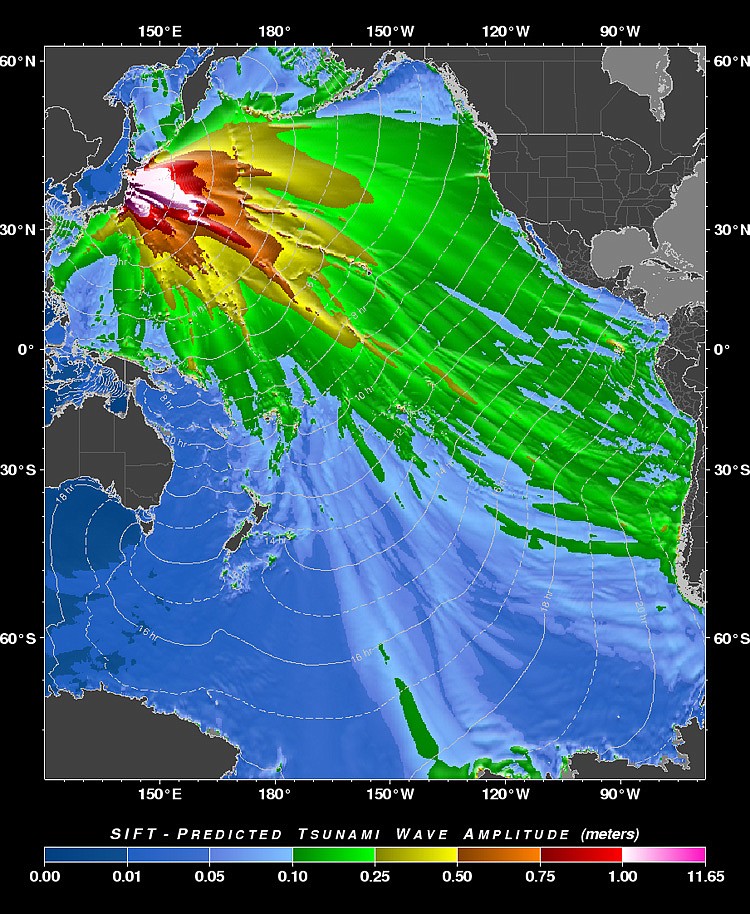By JAYMES SONG and MARK NIESSE
Associated Press
HONOLULU (AP) - Tsunami waves hit Hawaii in the early morning hours Friday and were sweeping through the island chain after an earthquake in Japan sparked evacuations throughout the Pacific and as far as the U.S. western coast.
The Pacific Tsunami Warning Center said Kauai was the first of the Hawaiian islands hit by the tsunami. Water rushed ashore in Honolulu, swamping the beach in Waikiki and surging over the break wall in the world-famous resort but stopping short of the area's high-rise hotels.
Waves about 6 feet high were recorded on Maui, and 3 feet in Oahu and Kauai. Officials warned that the waves would continue and could become larger, but a scientist at the tsunami warning center said it didn't appear that they would cause major damage in Hawaii.
"But there is going to be some damage, I'm sure," said geophysicist Gerard Fryer in Hawaii.
Roadways and beaches were empty as the tsunami struck the state, which had hours to prepare. Sirens sounded throughout the night, and residents in coastal areas were sent to refuge areas at community centers and schools while tourists were moved to higher floors of hotels. People waited in long lines stocking up on gas, bottled water, canned food and generators.
The tsunami, spawned by an 8.9-magnitude earthquake in Japan, slammed the eastern coast of Japan, sweeping away boats, cars, homes and people as widespread fires burned out of control. It raced across the Pacific at 500 mph - as fast as a jetliner - and could keep that speed until it hits a large land mass, though the waves roll into shore at normal speeds.
Waves are predicted to hit the western coast of the United States between 11 a.m. and 11:30 a.m. EST Friday. Evacuations were ordered in parts of Washington and Oregon, and fishermen in Crescent City, Calif., fired up their crab boats and left the harbor to ride out an expected swell. A tsunami in 1964 killed 11 people in Crescent City.
It was the second time in a little over a year that Hawaii and the U.S. West coast faced the threat of a massive tsunami. A magnitude-8.8 earthquake in Chile spawned warnings on Feb. 27, 2010, but the waves were much smaller than predicted and almost no damage was reported.
Scientists acknowledged they overstated the threat but defended their actions, saying they took the proper steps and learned the lessons of the 2004 Indonesian tsunami that killed thousands of people who didn't get enough warning.
On Friday, the Honolulu International Airport remained open but seven or eight jets bound for Hawaii have turned around, including some originating from Japan, the state Department of Transportation said.
All harbors are closed and vessels were being ordered to leave the harbor.
Many islands in the Pacific evacuated after the warnings were issued, but officials told residents to go home because the waves weren't as bad as expected. But the size of Hawaii's islands is expected to amplify the waves, which will crash hardest against harbors and inlets.
"They're going to be coming in with high currents, they can pick up boulders from the sea floor ... they can pick up cars, they can pick up fuel tanks, those things become battering rams and so it just amplifies the destruction in a big tsunami," said Chip McCreery, director for the Pacific Tsunami Warning Center.
Waves almost 5 feet high hit Midway, a tiny island in the North Pacific about 1,300 miles northwest of Honolulu.
The warnings issued by the Hawaii-based Pacific Tsunami Warning Center cover an area stretching the entire western coast of the United States and Canada from the Mexican border to Chignik Bay in Alaska.
In the Canadian pacific coast province of British Columbia, authorities evacuated marinas, beaches and other areas.
In Alaska, a dozen small communities along the Aleutian Island chain were on alert, but there were no reports of damage from a wave just over 5 feet.
Officials in two coastal Washington counties used an automated phone alert system, phoning residents on the coast and in low-lying areas and asking them to move to higher ground.
"We certainly don't want to cry wolf," said Sheriff Scott Johnson of Washington's Pacific County. "We just have to hope we're doing the right thing based on our information. We don't want to be wrong and have people hurt or killed.
In Oregon, sirens blasted in some coastal communities and at sunami caused by a magnitude of 8.1 earthquake near Unimak Islands, Alaska, that killed 165 people, mostly in Hawaii. In 1960, a magnitude 9.5 earthquake in southern Chile caused a tsunami that killed at least 1,716 people, including 61 people in Hilo. It also destroyed most of that city's downtown. On the U.S. mainland, a 1964 tsunami from a 9.2 magnitude earthquake in Prince William Sound, Alaska, struck Washington State, Oregon and California. It killed 128 people, including 11 in Crescent City, Calif.
--
Associated Press Writers contributing to this report include Audrey McAvoy in Honolulu, Denise Petski in Los Angeles, Kathy McCarthy in Seattle, Nigel Duara in Seaside, Ore., Jeff Barnard in Crescent City, Calif., Rob Gillies in Toronto, Michelle Price and Carson Walker in Phoenix. Niesse contributed from Ewa Beach, Hawaii.

